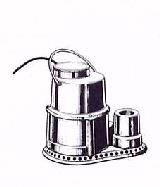|
|
.

Pedestal pump
|
|
|
.
.
|
| Sump Pumps |
|
| .... |
Need more information? Use our search box
Sump pump. Emergency back-up sump pump systems.
If the underground storm drainage lines in a house are lower than the public storm sewer or ditches, they can be connected to a sump (a receiving tank in the floor). A pump in the tank lifts the water to a higher level for discharge.
There are two types of sump pumps, pedestal-types and submersibles, as illustrated.
The pedestal type sump pump is the most common one. They usually are less expensive than submersible pumps. The motor is mounted on top of the drive shaft for cooling purposes. |
|
The motor is exposed to moisture and dust which will shorten its life span. It also is more noisy than the submersible pump.
Submersible sump pumps are equipped with a motor that is completely submersed in oil for better cooling and lifetime lubrication. Because it sits at the bottom of the sump submerged in water, it operates much quieter than the pedestal type sump pump.
Sump cover. All sumps should have a proper fitting cover. A few loose boards is no good enough. The purpose of the notched cover is to keep kids out as well as dirt and debris that could clog the pump's intake.
|

Submersible pump
|
Emergency back-up sump pump systems. Every sump pump should have a back-up system in case of power failure. Some systems use a battery as back-up and work on the same principal as emergency exit lights in public buildings, when the power supply is broken the battery kicks in.
There is also a sump pump back-up system that has no electrical or mechanical parts. The unit is hooked up to the municipal water supply. A vacuum is created and will draw the water in the sump out to the discharge pipe.
| WARNING. Some time ago a basement fire in my town was started by combustibles stored too close to a pedestal-type sump pump. |
|
|
|
|